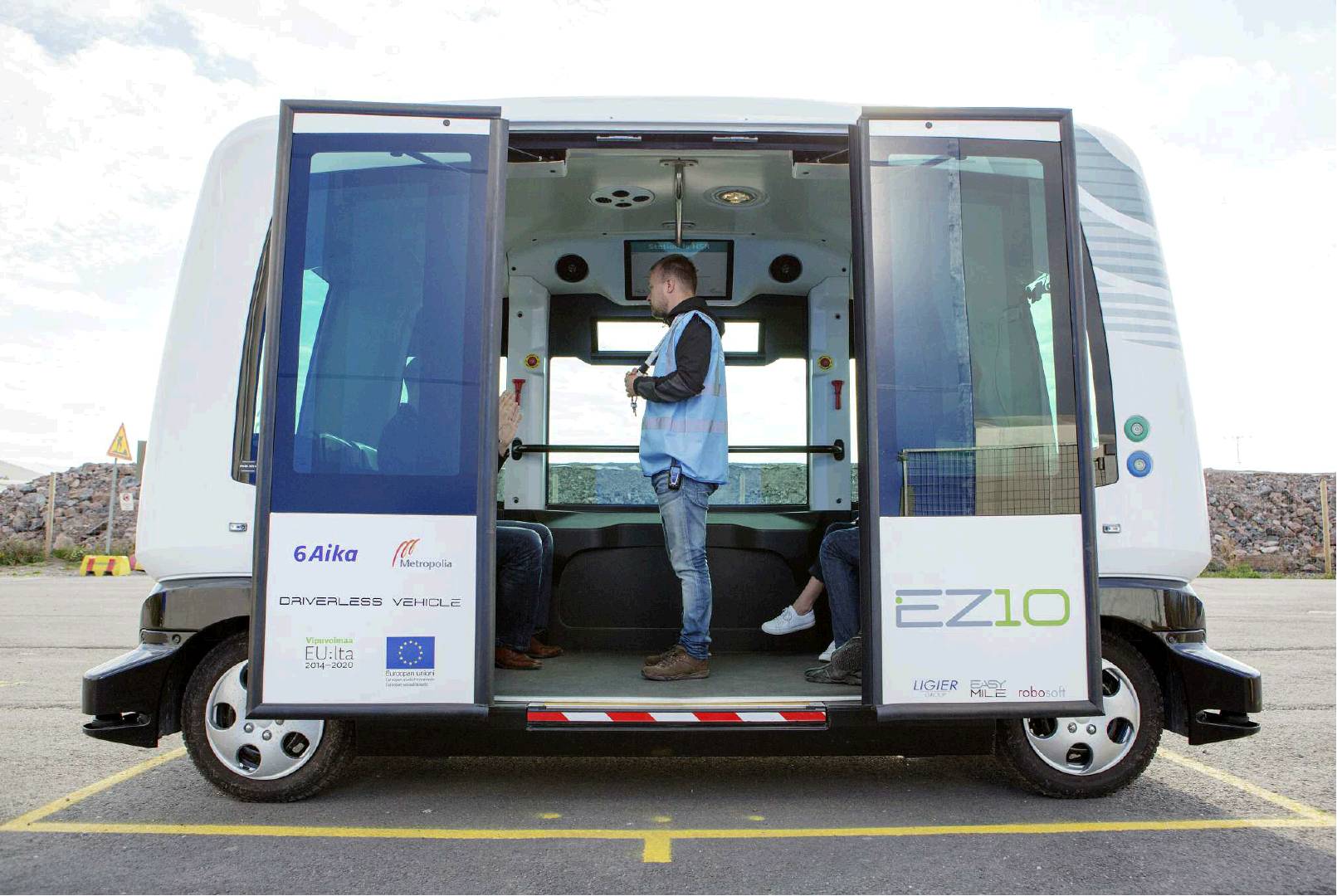DRIVERLESS BUS, AT 7 MPH, TAKES ROAD LEADING TO THE FUTURE
Putting safety first, Helsinki is rethinking transportation
By Henry Fountain NEW YORK TIMES
HELSINKI, Finland — A small electric bus chugged along at a slow but steady 7 mph when a white van, entering the street from the side, cut in front of it. The bus slowed, as if its driver had hit the brakes, and got back up to speed after the van moved out of the way.
But this bus has no brake or accelerator pedal. It has no steering wheel, either. In fact, it doesn’t have a driver — it operates using sensors and software, although for now, a person is stationed on board ready to hit a red “stop” button in an emergency.
At a time when self-driving cars are beginning to make progress — most notably with a trial program that the ride service Uber began this fall in Pittsburgh — the bus represents a different approach to technologically advanced transportation.
A driverless car, after all, is still a car, carrying at best a few people. By transporting many passengers on what could be very flexible routes, driverless buses could help reduce the number of cars clogging city streets.
It’s no surprise that the bus is being tested in Helsinki, which has been at the forefront of efforts to use technology to rethink public transportation.
Driverless buses like this one are being used in private, controlled settings, for example to shuttle students around a campus or employees on the grounds of an industrial plant. Helsinki is one of the first cities to run so-called autonomous buses on public roads in traffic; another project, in Sion, Switzerland, has been operating for several months, although the service was suspended in September for two weeks after a minor accident.
The Helsinki bus is a project of several universities with cooperation and money from government agencies and the European Union. The two-year, $1.2 million project, called Sohjoa, is just one manifestation of a movement to reduce the use of cars, and the traffic jams and greenhouse gases that come with them.
“A good possible outcome is that less and less people will own personal vehicles in the cities because they really don’t need them anymore,” said Harri Santamala, who coordinates the project and directs a “smart mobility” program at Helsinki Metropolia University of Applied Sciences.
In September, a Sohjoa bus, which can accommodate up to 12 passengers sitting and standing, made its debut on a straight, quarter-mile route in the city’s Hernesaari district, turning 180 degrees at both ends. The trip connected a popular sauna and restaurant at one end with several restaurants at the other, and attracted a small stream of curious riders.
“We chose this as a first route because we can study a huge amount of different traffic issues depending on the time of day,” Santamala said.
The buses are not as sophisticated as Uber’s self-driving cars, or those being developed by Google and other companies. Those are essentially “free-range” vehicles, able to travel just about anywhere by comparing what their sensors detect about roads and surroundings with a database that has been compiled by the cars over time. (Before Uber began offering rides in Pittsburgh, for example, employees drove its cars around the city for months, collecting data.)
The buses, made by a French company, are “taught” a route by having operators drive them using steering and acceleration controls on a small box. The route is then fine-tuned with software. In operation, the buses have laser sensors and GPS to keep them on the route, and can deviate only if alternate routes have been “learned” as well.
While the buses are designed to travel at about 15 mph, or 25 kph, they are running at half that for the Helsinki trials. Lateral movement is also restricted; if a car is double-parked along the route, for instance, the bus must wait until the car moves or the bus operator steers around it using the control box.
“We have to be very keen about safety,” Santamala said.
Those restrictions provide an underwhelming experience for now. The most excitement occurs when a vehicle such as the white van crosses too closely, or when a motorist approaches from the rear and, impatient with the bus’s tortoiselike pace, swerves around it.
Santamala said the project aimed to establish a real bus route — probably a seasonal one — in the next two years. And there’s no reason self-driving technology could not be applied to bigger buses eventually.
For now, the project is focusing on so-called last-mile service — taking riders from a stop on a more conventional bus line to a point closer to their homes, shops, offices or schools. An autonomous bus, presumably going faster, could be useful, especially because of a quirk in Finland’s motor vehicle laws.
Last month, the bus trials moved to a more complex route in Espoo, on Helsinki’s outskirts, and is now operating in Tampere, 111 miles (179 kilometers) to the north.
Santamala and his colleagues analyze each trip to learn how a self-driving bus differs from one operated by a human, and how motorists and pedestrians interact with it. One difference was apparent to everyone on the bus after the white van cut in front of it: There was no driver to yell at the driver of the van, which had pulled into a nearby parking space.
So Helena Bensky, a Helsinki resident who was giving the bus a try, offered to fill in.
“Should I go give that guy a telling off?” she asked.
